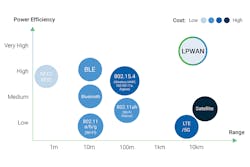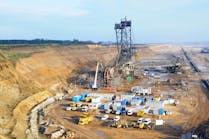5 compelling cases of LPWAN for process industries
Whether the industry is oil and gas, chemicals, pharmaceuticals or food and beverage, process manufacturers face common challenges of volatile market demands and constant pressure to improve operational performance. For many companies, failing to meet peak performance can result in devastating revenue losses. As the Internet of Things (IoT) ushers in the next industrial revolution, process manufacturers are among the first to catch this digital transformation wave.
At its core, IoT and its offspring, Industrial IoT (IIoT), involve data aggregation from thousands of smart sensors in functioning processes and equipment. Data is streamed to local, on-premise database or control systems, and/or cloud platforms where actionable insights are derived, to enable operational transparency and intelligent decision-making. These powerful IIoT applications are driven by new wireless connectivity that enables low-power and affordable "last-mile" communications from massive, granular data points.
Low Power Wide Area Networks (LPWAN)
Different from time-sensitive automation applications, a larger number of IIoT remote monitoring use cases require much lower bandwidth data transmission. For example, data on silo fill levels or ambient temperature typically don’t need to be updated at millisecond-latency. When it comes to IIoT sensor networks, what’s more important is the ability to connect a much larger base of data points in an affordable and power-efficient manner. Communications range is another critical requirement given the remote and challenging locations of many processes and assets. On top of that, ease of installation provides the flexibility to adapt and expand to dynamic business needs. In this context, wired solutions — expensive and cumbersome to implement, alter and expand — fail to deliver.
Purpose-built for large-scale, low data rate sensor networks operating on independent batteries, Low Power Wide Area Networks (LPWANs) are disrupting the IIoT landscape. In a 2018 survey conducted by ON World and the International Society of Automation (ISA), 57% of industrial IoT professionals reported that they were researching or developing LPWAN solutions.
An intriguing aspect of LPWANs is their multikilometer range and deep penetration capability, which outperform WiFi, Bluetooth and industrial wireless mesh (e.g., WirelessHART, ISA 100.11a). This makes them a viable solution for geographically dispersed and/or structurally dense industrial campuses like oil fields, refineries and process plants. At the same time, ultra-low power design sustains many years of battery life, which in turn contributes to lowering total cost of ownership (TCO) and environmental footprint. Compared to industrial mesh solutions, LPWANs can be implemented without complex network configuration and at a fraction of both device and operational costs.
It is important to note that network performance can greatly vary among different LPWAN options. For solutions operating in the license-free spectrum with many coexisting radio systems, interference resilience is a prerequisite to ensure optimal reliability of the radio link. Process manufacturers that are unfamiliar with LPWANs may find it challenging to compare and evaluate multiple options available in the market. As a rule of thumb, technologies built on rigorous industry standards published by standard development organizations offer proven quality, scalability and carrier-grade reliability. So far, Telegram Splitting — recognized in the ETSI standard for Low-Throughput Networks (ETSI TS 103 357) — is the first and only such worldwide standardized technology in the license-free LPWAN market.
Figure 2. LPWAN architecture
5 LPWAN use cases for process industries
The central value around IIoT is the unparalleled visibility into current operations. In this regard, a versatile LPWAN can connect everything, from stationary plant assets to mobile workers and their surroundings. It particularly excels at hard-to-access locations and in perilous environments where manual monitoring is too risky and simply ineffective.
1. Pipeline monitoring
Responsible for transporting gases and liquids across production, pipelines are an integral asset in oil and gas, chemical and other process industries. Pipeline leakage is a major operational risk due to significant financial, environmental and reputational impacts. Besides asset losses, the release of oil and other toxic substances results in severe pollution and associated astronomical fines. Similarly, gas and chemical leaks can be a trigger point for a catastrophic explosion with irreversible consequences.
Using LPWANs, manufacturers can collect vibration, strain, flow and acoustic readings from multiple sensor data points, to remotely monitor health and integrity of their pipeline systems. This allows for automation of manual activities like regular on-site visits for inspection and data recording. More importantly, structural damage and failures can be identified from the outset for early intervention to reduce repair and downtime costs while minimizing negative consequences.
2. Silo level monitoring
Silos and tanks are used across process industries for storing essential processing inputs and end products. Constant monitoring of these assets is needed for multiple purposes including production planning, inventory control and safety management. However, this is often challenging. Many silos and tanks are positioned far from the central operations center, at inconvenient locations in difficult terrain.
Even when manual reading is possible, it is labor-intensive and time-consuming while still not providing accurate insights into the current fill level. As such, refilling or emptying are done either too early or too late, leading to reduced productivity, costly production halts or wasteful and hazardous overfills. Chambers containing toxic chemicals additionally impose health risks to staff when collecting data. A robust LPWAN solution can tackle these issues by effectively connecting low-power sensors on remote tanks and silos. With real-time fill level data, plant managers can strategically schedule visits and the resources needed on demand to optimize staff productivity and safety.
3. Predictive maintenance
As process manufacturing is asset-intensive, equipment that does not operate at maximum capacity can considerably impair productivity. Preventive maintenance — performed on a predefined, regular basis — is inherently inefficient as it does not align with equipment conditions. Often times, such maintenance is done too frequently or worse, not timely enough — resulting in expensive and unnecessary production losses.
Amid growing call for demand-based predictive maintenance, versatile LPWANs provide the communications infrastructure for scalable condition monitoring of equipment. Measurements on current, temperature, pressure, vibration and other health parameters of critical assets can be cost-effectively transmitted from massive endpoints to a cloud-based or in-house analytics tool. Incoming data is then interpreted to diagnose any abnormal deviations alongside potential wear and tear of parts and components. As such, manufacturers can schedule maintenance only when required, thereby enhancing asset reliability while reducing service and downtime costs.
4. Environmental and cold chain monitoring
Environmental factors exert significant impacts on product quality and safety in many processes. Specifically, pharmaceutical, chemical, and food and beverage industries all strive to seamlessly monitor their cold chains to preserve characteristics and optimal shelf life of end products. Maintaining favorable humidity additionally plays a decisive role in minimizing mold and bacteria development while not compromising product quality. Likewise, in the pharmaceutical industry, proper dust control is central to avoid product contamination and mitigate harmful health effects on workers.
Rather than solely depending on the reliability of HVAC systems, manufacturers can leverage LPWAN-enabled sensor networks to obtain unprecedented visibility into critical ambient factors throughout production and storage. Disruptive conditions and their root cause (e.g., refrigerator and HVAC equipment malfunctions) can be detected early for counteractive measures before small issues turn into catastrophes.
5. Worker safety
Workers in processing plants are exposed to myriad dangers — from regular contact with toxic chemicals and airborne substances to fatal falls, equipment mishaps and explosion risks during inspection and maintenance. In addition to robust training and proper use of protective equipment, staying informed of employees’ health and their work surroundings can reduce the risk of fatal incidents and chronic diseases.
Typically, smart wearables can communicate on-site workers’ vital metrics like pulse and location over LPWAN to the operations center. In tandem with contextual data (e.g., air quality, heat, humidity, radiation) from environmental sensors, employees’ prolonged exposure to hazards, overexertion and accidents can be timely alerted for preventive actions. For example, encouraging workers to take a recovery break when needed can greatly improve worker productivity while circumventing fatigue-related injuries and incidents.
Ensuring optimal conditions of critical safety equipment with predictive maintenance also decreases the risk of equipment mishaps. By the same token, LPWAN-enabled remote monitoring eliminates regular manual inspection, thereby reducing workers’ contact with perilous equipment.
Wrapping up
IIoT is inherently multifaceted. While wired solutions continue to be the backbone for factory and process automation, LPWANs offer a complementary wireless infrastructure to realize a new host of powerful IIoT applications. Though wireless connectivity is not new to many process companies, LPWANs can help bolster their competitive edge by curtailing costs and augment efficiencies in multiple ways.
Range, power and cost advantages of these networks enable connection of previously inaccessible assets on an unprecedented scale and with data granularity. In addition, simple installation and management eliminate the expense and hassle associated with network configuration, implementation and expansion of alternative options. Nevertheless, not all LPWANs are created equal. Opting for a solution based on a proven industry standard will ensure carrier-grade reliability, security and long-term interoperability of the IIoT architecture.
Albert Behr is founder and CEO of Behr Technologies, worldwide licensee of MIOTYTM, the new commercial standard in LPWAN technology for IIoT. With 30 years of professional experience, Behr has led both the commercialization, financing and operational execution of some of the world’s most famous technology companies.




